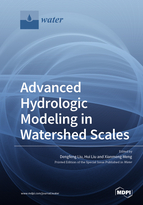Advanced Hydrologic Modeling in Watershed Scales
A special issue of Water (ISSN 2073-4441). This special issue belongs to the section "Hydrology".
Deadline for manuscript submissions: closed (30 October 2022) | Viewed by 27422
Special Issue Editors
Interests: watershed hydrological modeling; hydrological model; ecohydrological modeling; socio-hydrological modeling; ecohydrology
Special Issues, Collections and Topics in MDPI journals
Interests: hydrological modeling; ecohydrology; remote sensing; drought; Lancang–Mekong; hydraulics
Special Issue Information
Dear Colleagues,
Hydrologic modeling in the watershed scale is a key topic in the field of hydrology. The hydrological model is an important tool to understand the impact of climate change and human activities on rainfall–runoff processes, and especially on water resources for human beings in a changing environment. In traditional hydrological modeling, the precipitation data of in situ rainfall gauges are adopted to force hydrological modeling, and the simulated discharge is used to validate the hydrological model by comparing it with the observed discharge at the hydrological station. In the last two decades, with the development of satellite remote sensing and artificial intelligence, many new datasets and methods have been introduced into hydrological modeling. Multi-source fusion precipitation products (such as GPM, MSWEP, CMFD) and atmospheric assimilation datasets (such as CMADS) display better spatial distribution than ground rainfall data and have the potential for a better performance in hydrological modeling. Additionally, data on evaporation, soil moisture, and water level at the channel from remote sensing may be applied to validate the simulated evaporation, soil moisture, and discharge. Even water storage change can be evaluated by GRACE data. Deep learning models and agent-based models may be used in the process representation and parameter estimation. The interaction of hydrological processes to ecological processes and social processes has also attracted attention in recent years.
We invite original research articles that contribute to new progress in the hydrological modeling in the watershed scale under global changes. Among the topics of interest for this Special Issue are:
- Application of new datasets and methods in hydrological modeling;
- New process representation in hydrological modeling;
- Progress of parameter estimation;
- Interaction of hydrological processes to ecological processes and social processes and their co-evolution processes;
- Coupled modeling of surface water and groundwater;
- Flood and drought based on hydrological modeling;
- Flux observation in the validation of hydrological modeling;
- Isotopic tracing in the validation of hydrological modeling;
- Role of macropore flow or preferential flow in the hydrological process;
- Sediment and other mass transport in the hydrological process.
Prof. Dr. Dengfeng Liu
Dr. Hui Liu
Dr. Xianmeng Meng
Guest Editors
Manuscript Submission Information
Manuscripts should be submitted online at www.mdpi.com by registering and logging in to this website. Once you are registered, click here to go to the submission form. Manuscripts can be submitted until the deadline. All submissions that pass pre-check are peer-reviewed. Accepted papers will be published continuously in the journal (as soon as accepted) and will be listed together on the special issue website. Research articles, review articles as well as short communications are invited. For planned papers, a title and short abstract (about 100 words) can be sent to the Editorial Office for announcement on this website.
Submitted manuscripts should not have been published previously, nor be under consideration for publication elsewhere (except conference proceedings papers). All manuscripts are thoroughly refereed through a single-blind peer-review process. A guide for authors and other relevant information for submission of manuscripts is available on the Instructions for Authors page. Water is an international peer-reviewed open access semimonthly journal published by MDPI.
Please visit the Instructions for Authors page before submitting a manuscript. The Article Processing Charge (APC) for publication in this open access journal is 2600 CHF (Swiss Francs). Submitted papers should be well formatted and use good English. Authors may use MDPI's English editing service prior to publication or during author revisions.








